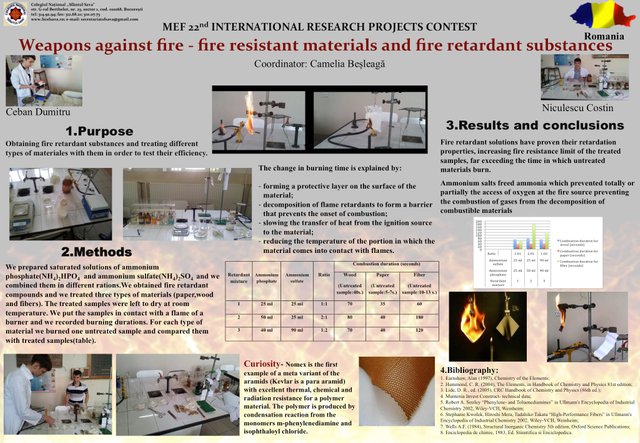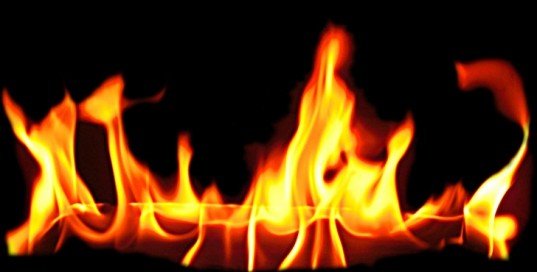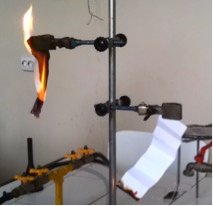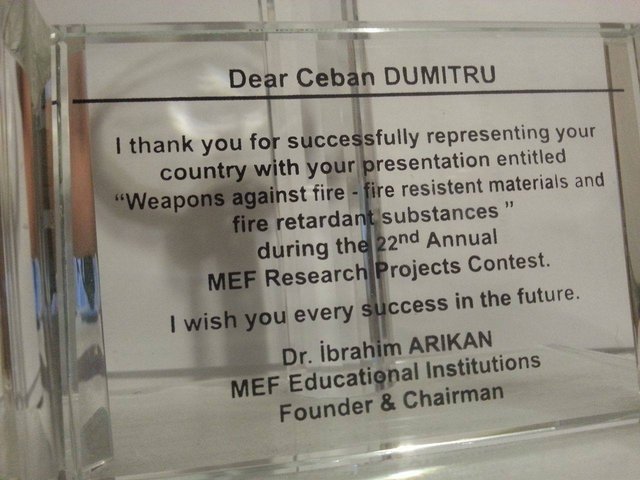This project is made together with @cebymaster. We prepared a experiment with great succes regarding flame retardants chemicals. We have participate in a competition but we couldn't managed to gain a product promotion. In introduction I will write about fire resistant materials and are flame retardants and their impact on fire. The experiment was a real succes and we hope in development finances to promote on a larger scale.

https://www.steemimg.com/image/MiJeh
A fire resistant material is one that is designed to resist burning and withstand heat. It is used in the bunker gear worn by firefighters to protect them from the flames of a burning building. Most auto racingdrivers also wear fire-retardant materials in case their car catches fire. Fire-retardant materials are designed to burn slowly, different to fire-resistant materials, which are designed to never burn.
What are flame retardants? A: Flame retardants are a key component in reducing the devastating impact of fires on people, property and the environment. They are added to or treat potentially flammable materials, including textiles and plastics. The term “flame retardant” refers to a function, not a family of chemicals. A variety of different chemicals, with different properties and structures, act as flame retardants and these chemicals are often combined for effectiveness.
Flame retardants are added to different materials or applied as a treatment to materials (e.g., textiles, plastics) to prevent fires from starting, limit the spread of fire and minimize fire damage. A variety of flame retardants is necessary because materials that need to be made fire-resistant are very different in their physical nature and chemical composition, so they behave differently during combustion. The elements in flame retardants also react differently with fire. As a result, flame retardants have to be matched appropriately to each type of material. Bromine, phosphorus, nitrogen and chlorine are commonly used in flame retardants. Inorganic compounds are also used in flame retardants, either alone or as part of a flame retardant system in conjunction with bromine, phosphorus or nitrogen. Experts recognize the use of flame retardants is essential to stopping or slowing the spread of fire.

Q: How do flame retardants work? A: Flame retardants are added to different materials or applied as a treatment to materials (e.g., textiles, plastics) to prevent fires from starting, limit the spread of fire and minimize fire damage. Some flame retardants work effectively on their own; others act as “synergists” to increase the fire protective benefits of other flame retardants. A variety of flame retardants is necessary because materials that need to be made fire-resistant are very different in their physical nature and chemical composition, so they behave differently during combustion. The elements in flame retardants also react differently with fire. As a result, flame retardants have to be matched appropriately to each type of material. Flame retardants work to stop or delay fire, but, depending on their chemical makeup, they interact at different stages of the fire cycle.
Experimental part : We prepared saturated solutions of ammonium phosphate(NH4)2HPO4 and ammonium sulfate(NH4)2SO4 and we combined them in different rations.We obtained fire retardant compounds and we treated three types of materials (paper,wood and fibers). The treated samples were left to dry at room temperature. We put the samples in contact with a flame of a burner and we recorded burning durations. For each type of material we burned one untreated sample and compared them with treated samples(table).
The change in burning time is explained by:
- forming a protective layer on the surface of the material;
- decomposition of flame retardants to form a barrier that prevents the onset of combustion;
- slowing the transfer of heat from the ignition source to the material;
- reducing the temperature of the portion in which the material comes into contact with flames.
Fire retardant solutions have proven their retardation properties, increasing fire resistance limit of the treated samples, far exceeding the time in which untreated materials burn. Ammonium salts freed ammonia which prevented totally or partially the access of oxygen at the fire source preventing the combustion of gases from the decomposition of combustible materials
The combined solutions were saturated, aiming to maximum effect the fireproofing, neglecting the concentration of ammonia can be dangerous scale. In an advanced stage of production of fireproof solutions requires a thorough analysis of the toxicity of the fumes that can become as lethal as the fire in case of fire.

After obtaining retardant mixtures, we decided to treat three types of samples in order to observe the fireproofing effectiveness of different structures. I used samples of wood, paper and cloth.
The samples were immersed in the resulting mixture, using the method of treatment of the material mass. They used samples of the same origin and size for each substance.


After removal of the substance, their drying was done by spraying, without mechanical intervention
- Comparison between the untreated sample and the treated material


Mixtures have proven flame retardant properties, increasing the limit of fire resistance of samples treated well beyond the time in which untreated materials burn.
Conclusion
We noted that once the evidence of cloth (fiber) carbonized surface, the material becomes almost non-flammable sample fiber is left over a burner Teclu more than thirty minutes at the end of which has kept almost all shape and surface . Although the tensile strength of the material decreases, when compared with the untreated sample, which was converted to the ash, the effect is positive.
Paper and fiber, the effect was to increase the limit of fire resistance and keeping the original structure, LD.
The importance of these substances is high in a society where annual fires causing loss of life and severe property. Thousands of people, especially children and the elderly, victims of fires every year and material losses amounting to billions of euros worldwide.

Bibliography:
1. Earnshaw, Alan (1997). Chemistry of the Elements
2. Hammond, C. R. (2004). The Elements, in Handbook of Chemistry and Physics 81st edition.
3. Lide, D. R., ed. (2005). CRC Handbook of Chemistry and Physics (86th ed.)
4 Robert A. Smiley “Phenylene- and Toluenediamines” in Ullmann's Encyclopedia of Industrial Chemistry 2002, Wiley-VCH, Weinheim.
5. Stephanie Kwolek, Hiroshi Mera, Tadahiko Takata “High-Performance Fibers” in Ullmann's Encyclopedia of Industrial Chemistry 2002, Wiley-VCH, Weinheim.
6. Wells A.F. (1984) Structural Inorganic Chemistry 5th edition Oxford Science Publications
Very nice, rare post :) - you can try better formatting by using headers like this.. for example.
What are flame retardants?
Flame retardants are a key component in reducing the devastating impact of fires on people, property and the environment..
Conclusion
We noted that once the evidence of cloth (fiber) carbonized surface, the material becomes almost non-flammable sample fiber is left over a burner Teclu more than thirty minutes at the end of which has kept almost all shape and surface..
Downvoting a post can decrease pending rewards and make it less visible. Common reasons:
Submit
@kevinwong, after the treatment with this solution, the material will carbonize in contact to the fire. The material will mentain its structure but will be easy to break after the action of fire.
Downvoting a post can decrease pending rewards and make it less visible. Common reasons:
Submit